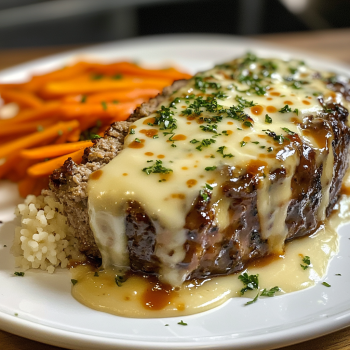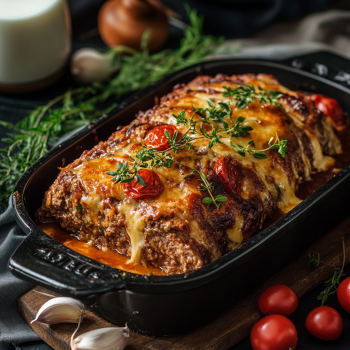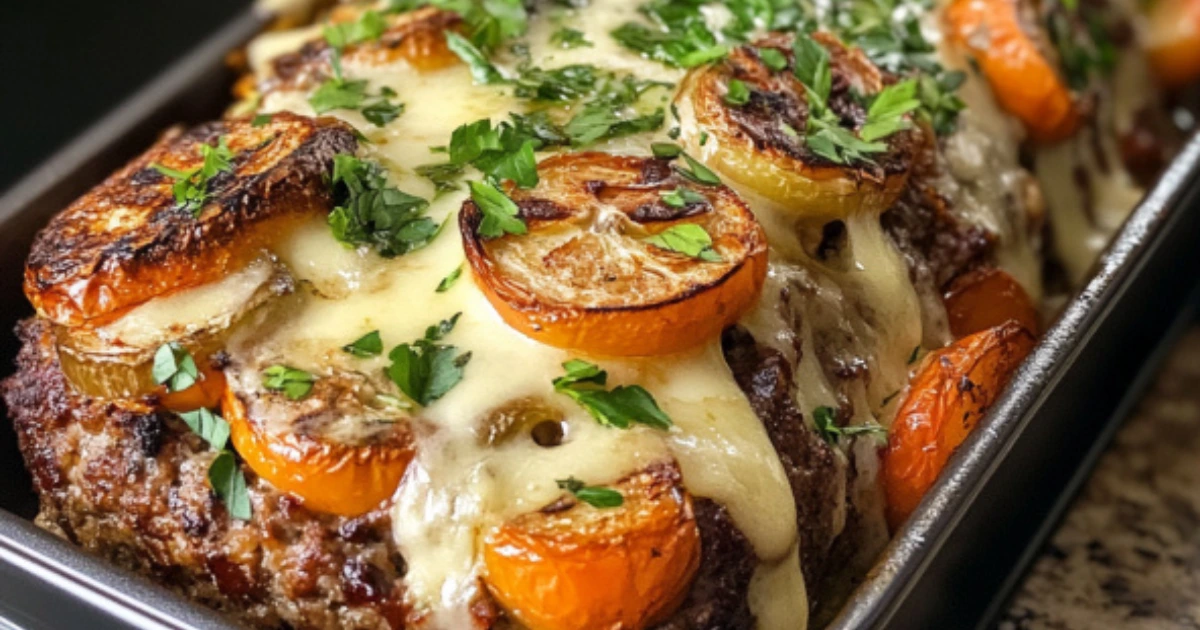Introduction
Why Milk Instead of Water in Meatloaf? An Introduction to the Moisture Debate
Why milk instead of water in meatloaf ? Meatloaf is a classic comfort food enjoyed worldwide. It has stood the test of time due to its hearty nature, simplicity, and versatility. Typically made with ground meat, breadcrumbs, and seasonings, it’s a dish that can easily be customized to suit various tastes. While the basic ingredients remain constant, what truly sets a meatloaf apart is how it retains its moisture and flavor during cooking. This is where understanding the role of liquids, especially milk, can make a big difference in the final texture and taste of your meatloaf.
Table of Contents
Importance of Moisture in Meatloaf
The moisture content in meatloaf is essential for achieving the perfect balance of tenderness and flavor. Without adequate moisture, the meatloaf may turn out dry, dense, and unappealing. This is why it’s crucial to use the right liquid, such as milk, to ensure the loaf stays juicy and flavorful. The liquid helps bind the ingredients together while enhancing the overall texture, making each bite tender and moist.
Understanding the Role of Liquid
Why Liquid is Essential in Meatloaf: A Deep Dive into Its Role
Liquid is a key component in any meatloaf recipe. It helps to bind the ingredients together and prevents the loaf from becoming too dry. Without the right amount of liquid, the meatloaf will be tough and hard to slice. Liquids also contribute to the overall flavor profile of the dish, infusing the meat with additional moisture that keeps it from becoming bland.
Different Liquids Used in Meatloaf: Why Milk Is Preferred
Many recipes use various types of liquids to achieve the desired moisture and flavor. Common options include:
- Broth (beef, chicken, or vegetable)
- Milk
- Tomato sauce or ketchup
- Eggs (though not technically a liquid, they act as a binder)
Among these, milk is often considered the best option due to its ability to contribute both flavor and creaminess to the meatloaf mixture.
Benefits of Using milk instead of water in meatloaf
Enhancing Flavor with Milk in Meatloaf
One of the main reasons for using milk in meatloaf is the enhanced flavor it provides. Unlike water, which is neutral, milk adds a subtle richness that elevates the entire dish. The fats and sugars found in milk contribute to a deeper, more complex taste. As the meatloaf bakes, the milk infuses the meat and the other ingredients, resulting in a moist and flavorful loaf.
Adding Creaminess: Why Milk is a Key Ingredient
In addition to flavor, milk helps create a creamy texture that makes the meatloaf easier to slice and more enjoyable to eat. This creaminess also helps the loaf hold its shape better, preventing it from crumbling. As the milk combines with the other ingredients, it softens the breadcrumbs or oats, making them more pliable and contributing to a smoother consistency.
Improving Texture
Another benefit of using milk in your meatloaf is the improvement in overall texture. The liquid helps to soften the meat, creating a more tender and juicy loaf. This results in a moist texture that is less likely to dry out during cooking. By providing a creamy base, milk ensures the meatloaf doesn’t become dense or heavy, but rather light and airy with a melt-in-your-mouth consistency.
Why Not Water?
The Lack of Flavor in Water Compared to Milk
Many people wonder, why milk instead of water in meatloaf? The primary reason is that water lacks the richness and flavor that milk provides. While water may serve the basic purpose of adding moisture, it does not contribute any extra taste or texture to the meatloaf. As a result, the dish can end up flat or bland, lacking the depth that milk’s fats and sugars can offer.
Nutritional Comparison: Water vs. Milk in Meatloaf
When you compare the nutritional contributions of water and milk, it’s clear that milk offers more benefits. While water may hydrate the meat, it does not add any nutrients like protein, calcium, or vitamins. In contrast, milk contributes a moderate amount of protein and fat, making it not only a flavor-enhancing ingredient but also one that offers nutritional value. This is particularly beneficial when preparing a well-rounded, satisfying meal for the whole family.
The Science Behind Milk
Milk’s Composition and How It Impacts Meatloaf Texture
The secret to milk’s effectiveness in meatloaf lies in its composition. Milk contains a balanced mix of fats, proteins, and sugars, all of which play a role in the final texture and flavor of your meatloaf. The fat content in milk helps tenderize the meat, while the proteins provide structure. The lactose (sugar) in milk also helps to create a slight caramelization during baking, adding to the richness of the flavor.
How Milk Interacts with Other Ingredients to Enhance Juiciness
When combined with the other ingredients, milk works synergistically to improve the overall texture. It hydrates the breadcrumbs or oats, helping them absorb moisture and expand, which results in a light, fluffy meatloaf. Moreover, milk helps distribute the seasonings evenly throughout the mixture, ensuring every bite is packed with flavor.
Choosing the Right Milk
Whole Milk vs. Low-Fat Milk: Which One Is Better for Meatloaf?
When considering why milk instead of water in meatloaf, you may also wonder what type of milk to use. The answer depends on your preferences and dietary needs. Whole milk offers the richest flavor and texture, thanks to its higher fat content. On the other hand, low-fat milk can still provide moisture without the added fat. Both options can be used in meatloaf, but whole milk is often the preferred choice for its creaminess and flavor.
Non-Dairy Milk Alternatives in Meatloaf
For those who prefer non-dairy options, several alternatives can be used in place of milk. Options like almond milk, soy milk, or oat milk work well, though they may have slightly different flavor profiles. If you’re aiming for a richer texture, choose a non-dairy milk with a higher fat content, like coconut milk. These alternatives allow you to achieve a moist meatloaf while accommodating various dietary preferences.
Combining Milk with Breadcrumbs

Soaked Breadcrumbs and Milk: A Perfect Combination
To ensure your meatloaf stays juicy, it’s essential to combine milk with breadcrumbs or other fillers. The liquid hydrates the breadcrumbs, allowing them to absorb moisture and soften. This results in a moist and tender loaf that holds together well and doesn’t fall apart during baking.
How Soaked Breadcrumbs Improve Meatloaf Texture
Soaking breadcrumbs in milk creates a creamy texture that enhances the moistness of the meatloaf. The liquid prevents the bread from becoming too dry or hard, ensuring that each bite is soft and flavorful. This technique not only improves texture but also adds to the overall juiciness, ensuring that your meatloaf is perfectly moist.
Tips for Perfectly Incorporating Milk
Best Ratios of Milk to Meatloaf Mixture
When preparing meatloaf, why milk instead of water in meatloaf? The right ratio of milk to meatloaf mixture is crucial for achieving a juicy and tender result. Typically, you’ll need about 1/2 cup of milk for every pound of ground meat in your recipe. However, this ratio can vary depending on the other ingredients used. If you’re incorporating breadcrumbs or oats, you may need slightly more milk to ensure the loaf remains moist. Remember, the key is to balance the moisture without making the mixture too runny.
Avoiding Common Mistakes
When adding milk to the meatloaf mixture, it’s essential to avoid overdoing it. Too much milk can make the loaf soggy and affect its ability to hold shape. On the other hand, not adding enough can result in a dry meatloaf. It’s best to start with the recommended amount of milk and adjust as needed. Also, ensure that the breadcrumbs or other binders are adequately soaked in milk before mixing, as this allows for better moisture distribution throughout the meatloaf.
Substitutes for Milk in Meatloaf
Dairy-Free Options
For those who cannot consume dairy or prefer non-dairy options, there are several alternatives to milk that can still provide the moisture and texture needed for a perfect meatloaf. Popular options include:
- Almond milk
- Soy milk
- Coconut milk
- Rice milk
These dairy-free options work well in most meatloaf recipes, although they may have slightly different flavor profiles. Be sure to choose an unsweetened variety to avoid affecting the flavor of your meatloaf.
Broth and Cream Alternatives
In place of milk, you can also use broth or cream. Chicken broth, beef broth, or vegetable broth can add an extra layer of flavor to your meatloaf while keeping it moist. Heavy cream is another alternative that will not only add moisture but also increase the richness and creaminess of the meatloaf. If you opt for cream, use it sparingly to avoid overwhelming the dish with too much fat.
Flavor Pairing with Milk
Ingredients That Complement Milk’s Richness
Milk’s richness enhances the flavor of your meatloaf and complements other ingredients. For the best results, pair milk with ingredients such as:
- Garlic
- Onions
- Herbs like parsley and thyme
- Cheese (grated cheese adds flavor and moisture)
These ingredients work well with the creamy texture of milk, ensuring a well-balanced and flavorful meatloaf. Additionally, consider adding a small amount of tomato paste or Worcestershire sauce to deepen the flavor profile.
Creating a Balanced Flavor Profile
When using milk, it’s essential to maintain a balanced flavor profile. The milk’s mildness helps to mellow out the strong flavors of the meat, spices, and seasonings. Adding too many overpowering ingredients can detract from the harmony of the dish. For a balanced taste, use a moderate amount of salt and pepper, and complement the flavors with herbs or umami-rich ingredients like mushrooms or soy sauce.
Cooking Methods That Retain Moisture
Baking Tips for Why milk instead of water in meatloaf

When cooking meatloaf with milk, baking at the right temperature is key. Typically, meatloaf should be baked at 350°F (175°C) for about 1 hour. This allows the milk to provide consistent moisture throughout the cooking process. Baking at a lower temperature may cause the meatloaf to dry out, while a higher temperature could result in uneven cooking. Slow and steady is the way to go for a moist, tender meatloaf.
For side dish inspiration, explore Bob Evans mashed potatoes.
Covering vs. Uncovering Meatloaf
Whether or not to cover the meatloaf while baking is an important consideration. If you cover it with foil during the first 30-40 minutes, it helps retain moisture and prevent the crust from becoming too hard. In the final stages of baking, uncovering the meatloaf allows the top to become beautifully browned and slightly caramelized. This balance of moisture retention and crispness is essential for achieving the perfect texture.
Troubleshooting Common Problems
When Meatloaf Is Too Dry
If you’ve added milk and followed the recipe but still find your meatloaf dry, consider adjusting the amount of liquid next time. Sometimes, the type of meat used can affect moisture retention. Lean meats, like turkey or chicken, might require extra liquid. Also, ensure that the breadcrumbs or fillers are well-soaked in milk before mixing, as this will help retain moisture.
Fixing a Soggy Meatloaf
If your meatloaf turns out too soggy, it may be due to an excessive amount of milk. To fix this, you can drain any excess liquid or add more breadcrumbs to absorb the moisture. Additionally, try increasing the baking time or baking at a slightly higher temperature to allow more moisture to evaporate, leaving behind a moist but firm meatloaf.
Health Considerations
Nutritional Benefits of Milk
In addition to making your meatloaf juicier, milk offers several nutritional benefits. It provides essential calcium, vitamin D, and protein, which help to support bone health and muscle repair. Using milk in meatloaf can enhance the nutritional profile of your dish, especially if you’re looking for ways to boost protein intake while maintaining a juicy texture.
Lower-Calorie Options for Health-Conscious Cooks
For health-conscious cooks, there are ways to keep the meatloaf moist without adding excess calories. Opting for low-fat or skim milk can help reduce the overall fat content, while still maintaining the necessary moisture. Alternatively, using broth or a combination of non-dairy milk and vegetables as fillers can provide a low-calorie, high-moisture solution for a healthy meatloaf.
Cultural Perspectives on Why milk instead of water in meatloaf ?
Regional Variations in Liquid Choices
Different regions have their unique takes on meatloaf, often with varying types of liquids used. In some cultures, milk is replaced with stock for added depth of flavor. For example, in parts of Italy, tomato sauce might replace milk, contributing to a different texture and flavor profile. Understanding these regional variations can help you discover new ways to incorporate liquids into your meatloaf.
Traditional Recipes Using Milk
In traditional American meatloaf recipes, milk has long been a staple. The combination of milk, breadcrumbs, and ground beef is a hallmark of the classic American meatloaf. Over time, people have modified this dish with local ingredients, but milk remains a constant for providing moisture and a smooth, tender texture.
FAQs About Why milk instead of water in meatloaf ?
Six Frequently Asked Questions About Using Milk in Meatloaf
- Why use milk instead of water in meatloaf?
Milk adds richness and creaminess that water cannot provide, making the meatloaf juicier and more flavorful. - Can I use almond milk for a dairy-free version?
Yes, almond milk works well as a dairy-free alternative, though it may slightly alter the flavor profile. - How much milk should I use?
Typically, use about 1/2 cup of milk per pound of meat, adjusting for the type of meat and other ingredients. - Can I use broth instead of milk?
Yes, broth is a good alternative, adding flavor while still providing moisture. - Is low-fat milk a good substitute?
Yes, low-fat milk can be used, though it will provide slightly less richness than whole milk. - Can I make meatloaf without milk?
While possible, meatloaf without milk may not be as moist or flavorful. Consider using alternatives like broth or non-dairy milk.
Conclusion
In conclusion, milk plays a crucial role in achieving the perfect meatloaf. Its richness and moisture-enhancing properties make it an ideal liquid choice over water. By understanding how to incorporate milk properly, experimenting with alternative liquids, and following best cooking practices, you can ensure that your meatloaf is tender, juicy, and full of flavor.

